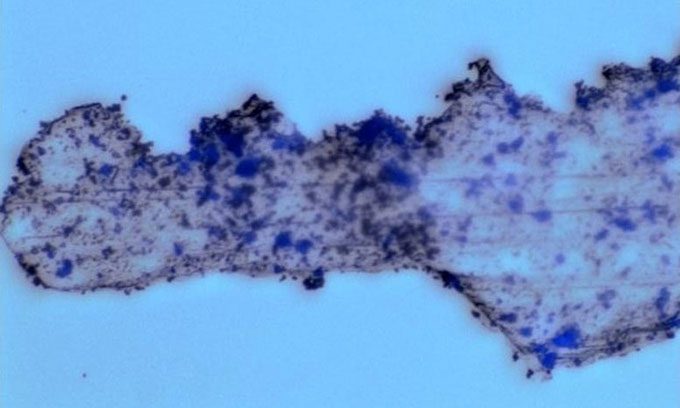Scientists Create Tiny Catalysts That Can Move on Their Own Under Sunlight and Adhere to Microplastics.
Expert Martin Pumera at the Advanced Nano Robotics Center (Czech Republic) and his colleagues have developed a microscale robot capable of swimming, adhering to, and degrading plastic fragments, as reported by SciTechDaily on June 14. The new study was published in the journal ACS Applied Materials & Interfaces.

Tiny catalytic robot (dark blue dot) covering microplastics. (Photo: ACS Applied Materials & Interfaces).
While plastic products are ubiquitous in homes, waste and small plastic fragments are overwhelming the environment. Microplastics, measuring less than 5 mm, are particularly difficult to collect and remove. They can absorb heavy metals and pollutants, posing risks to humans and animals if ingested.
Previously, researchers proposed an energy-efficient solution for removing plastics from the environment: using catalysts. These catalysts rely on sunlight to create reactive compounds capable of degrading plastic. However, achieving contact between the catalyst and plastic fragments is challenging, often requiring pre-treatment or bulky machinery that is not easily scalable.
Pumera’s research team aimed to create a self-propelling catalyst powered by sunlight, capable of adhering to microplastic particles and degrading them. To transform the catalyst into a tiny robot that operates using light, they created bismuth vanadate particles (an inorganic compound with the formula BiVO4) in star shapes measuring 4-8 micrometers, then uniformly coated them with magnetic iron oxide. The tiny robots can swim along water channels and interact with microplastics.
The scientists discovered that under visible light, the tiny robots firmly adhered to four common types of plastics. They then illuminated the plastic fragments covered by the catalytic robots for 7 days, all submerged in a diluted hydrogen peroxide solution. The research team observed that the plastic fragments lost 3% of their weight, while the surface structure transitioned from smooth to porous, with small molecules and components of the plastic found in the remaining solution.
To conduct the research, the team received funding from the European Regional Development Fund (ERDF). They stated that the tiny catalytic robots will pave the way for developing systems to capture and degrade microplastics in hard-to-reach areas.



















































